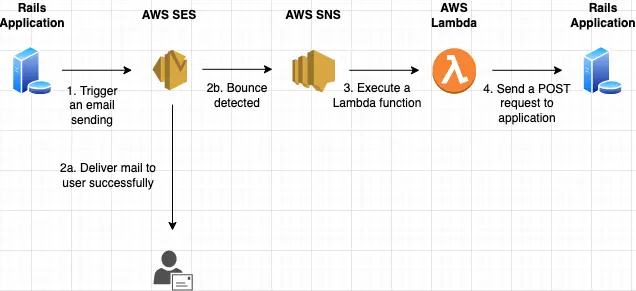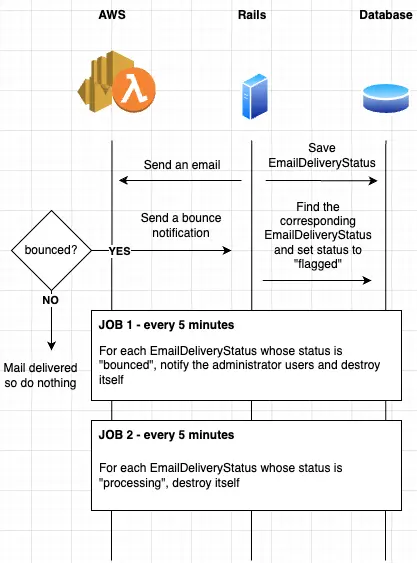If you are thinking of implementing a mailing system for your application, you would surely need to find a way to know if the sent emails are successfully delivered or not. With AWS SES (Simple Email Service), it is possible to set up bounce webhook notifications whenever an email failed to be delivered.
In one of my recent backend projects at Monstarlab, I needed to find a way to notify administrator users whenever an email sent from the Rails application (through AWS SES) fails to reach the recipients. In this article, I will explain the approach I took for implementing such a system.
Prerequisite: AWS SES setup to send email from a particular domain
The first thing you need to do is to create a domain identity for your domain through the AWS console by navigating to Amazon SES > Configuration > Verified identities. You will then need to verify it to confirm that the domain you are using is effectively yours.
※ I will not go into the details for this setup. If you need some explanations about how to setup a particular domain for sending email, this guide from the AWS documentation will certainly help you: https://docs.aws.amazon.com/ses/latest/dg/creating-identities.html#verify-domain-procedure
Overview
The objective is to find a way to notify administrator users whenever an email sent from the Rails application (through AWS SES) fails to reach the recipients.
For this, we came up with the below design in order to implement our solution.
- Rails will be configured to use AWS SES to send emails.
- AWS SES will trigger a SNS topic subscription whenever a bounce is detected.
- SNS will then trigger an AWS Lambda function that will send a POST request to the Rails application.
- Rails application will then perform the appropriate action (in our case, notify the administrator users)

Setting up AWS SES with SNS (Simple Notification Service) to send bounced notification
Now, let’s dive into the mail topic: the bounce email handling.
By default, no notification of any sort is sent when AWS SES fails to deliver an email. We need to set it up manually through the AWS console by navigating to Amazon SES > Configuration > Verified identities > (your domain) > Notifications.

You can see that we can setup SNS topic for three types of event:
- Bounce (when the email cannot be delivered for some reason)
- Complaint (when your sender email is marked as undesirable by the email recipient)
- Delivery (when the email is successfully delivered)
We need to create a SNS topic and assign it to the bounce notification.
Creating a SNS Topic
Following this, we will have to create a subscription to the created topic to be able to perform an action. In our case, we decided to send a webhook request to the Rails backend application so that the related administrator users for the bounced email can be notified.
Creating a Lambda function for that topic
The subscription will be an AWS Lambda function that will be called whenever there is a bounce notification. This function will send a request to the provided ENDPOINT_URL (which is an endpoint of our backend application) along with the SNS body data that is containing useful data for our backend to identify the bounced email (like the message ID and also the message body).
import json
import requests
import os
def lambda_handler(event, context):
url = "https://monstar-lab.com/aws/receive_bounce_notice"
# Body of the request
# In case the sns_message_payload["Type"] == 'SubscriptionConfirmation', the body will contain a url ('SubscribeURL'). The backend application will need to send a get request to that url to confirm it is ready to receive the notifications from now
# Non exhaustive body example: { "SubscribeURL" => "https://aws.ses.com" }
#
# In case the sns_message_payload["Type"] == 'Notification', the body will contain data about the bounced email such as message ID, the sender and recipient(s) etc.
# Non exhaustive body example:
# {
# ...
# "Message": "{\"mail\":{\"timestamp\":\"2022-08-24T13:01:50.867Z\",\"source\":\"no_reply@dev-sc-bcc.com\",\"sourceArn\":\"arn:aws:ses:ap-northeast-1:013046240018:identity/dev-sc-bcc.com\",\"sourceIp\":\"10.0.78.173\",\"callerIdentity\":\"ses-smtp-user.20220530-164025\",\"sendingAccountId\":\"013046240018\",\"messageId\":\"01060182cff1dd93-75aeab42-e753-4ef6-b977-347b64eccb89-000000\",\"destination\":[\"non-existing-email4@monstar-lab.com\"]}}",
#
sns_message_payload = event["Records"][0]["Sns"]
sns_message_headers = {
"x-amz-sns-message-type": sns_message_payload["Type"], # Can be either SubscriptionConfirmation (for checking the endpoint is ready to get notifications) or Notification (for a simple notification)
}
try:
r = requests.post(url = url, data = json.dumps(sns_message_payload), headers = sns_message_headers)
print(r)
return {
'statusCode': 200,
'body': json.dumps(str(r))
}
except Exception as e:
print(e)
return {
'statusCode': 500,
'body': json.dumps(str(e))
}
Once the lambda function, it is necessary to set the previously created SNS topic as the function trigger.
And voilà, we are done on the AWS side! We have successfully setup a system that will send a webhook request with relevant data to the backend application whenever there is a email that has failed to deliver! 🥳
Handling the notifications on the Rails side
In the last part, we could have just sent an email to a particular email address instead of sending a webhook request to the application whenever there is a bounce notification. But in our case, depending on the email that was bounced, the recipients to be notified of this incident are different and only our backend application can identify them.
※ I will not explain the details of setting up the mailer inside Rails in this article.
In order, we will:
- Create a table for storing the emails that are being sent
- Configure the mailer so that every time an email is sent, the data is saved into the database
- Create a controller that will be responsible of receiving webhook requests in case of bouncing
- Creating a cron job that will run periodically to check any bounced email and notify the corresponding administrator users
- Creating another cron job that will periodically delete all non-bounced emails sent at least one day before

Creating a table that will hold the email
Below is the structure of the table that is going to store all the email data.
class CreateEmailDeliveryStatuses < ActiveRecord::Migration[7.0]
def change
create_table :email_delivery_statuses do |t|
t.string :message_id, null: false # Message ID generated by SES
t.references :user, null: false, polymorphic: true # User linked to that email
t.string :recipient_email, null: false # Recipient email address
t.string :email_type, null: false # Method name that trigger the email sending
t.datetime :sent_at, null: false # Date and time of email sending
t.integer :delivery_status, null: false, default: 0 # Delivery status that can be either "processing" or "bounced"
t.text :raw_bounced_notification # The bounce notification body (for debug purposes)
t.timestamps
end
add_index :email_delivery_statuses, :message_id, unique: true
end
end
Configuring the mailer to save sent email data
Before diving into the code, one configuration is necessary in order to get the message ID generated by SES. You must set return_response to true inside the smtp_settings. Otherwise, it will be impossible to retrieve that ID allowing us to identify which email has bounced.
config.action_mailer.smtp_settings = {
address: ENV["STMP_ADDRESS"],
port: 587,
domain: ENV["STMP_DOMAIN"],
user_name: ENV["STMP_USERNAME"],
password: ENV["STMP_PASSWORD"],
authentication: :login,
enable_starttls_auto: true,
return_response: true
}
Next, let’s see the code that will take care of the email sending.
We have the ApplicationMailer class inheriting ActionMailer::Base that contains the methods for effectively sending the emails (in our case, only send_dummy_email).
Notice that the default delivery_job is overriden by Jobs::EmailDeliveryJob that will take care of saving email data into the database each time a email sending method is called.
# typed: false
# frozen_string_literal: true
class ApplicationMailer < ActionMailer::Base
self.delivery_job = Jobs::EmailDeliveryJob
default from: "no-reply@monstar-lab.com"
layout "mailer"
def send_dummy_email
@user = params[:user]
mail(to: user.email, subject: "Dummy Email")
end
end
# frozen_string_literal: true
# Job class inheriting ActionMailer::MailDeliveryJob
# This job will call the parent method (via super) for sending the email
# and then save the delivery data in the EmailDeliveryStatus table
# In case of a bounce notification sent by SNS, the failed email will be searchable via the message_id
# and then concerned parties will be notified of the mail delivery failure
class Jobs::EmailDeliveryJob < ActionMailer::MailDeliveryJob
queue_as QueueConfig.queues["default"]
def perform(mailer, mail_method, delivery_method, args:, kwargs: nil, params: nil)
response = super # Call the parent ActionMailer::MailDeliveryJob `perform` method to send the email
# Store the record inside EmailDeliveryStatus
user = params[:user]
# Get the message ID generated by SES
# example of response.string => "250 Ok 01060182ed4b24c8-e37b3174-b156-4032-b71b-0a636552035f-000000\n"
message_id = response.string[7..66]
return if user.blank?
EmailDeliveryStatus.create!(
message_id: message_id,
user: user,
recipient_email: user.email,
email_type: "#{mailer}.#{mail_method}",
sent_at: Time.zone.now,
delivery_status: "processing"
)
end
end
※ Note: this article (in Japanese) helped me find a way to retrieve the message ID generated by SES: https://kossy-web-engineer.hatenablog.com/entry/2020/05/30/124520
Now, every time a message is sent via the following code, an EmailDeliveryStatus record will be created with the message ID. We will be able to identify which user is related to that email and what kind of email it is.
# Sending en email to @user.email
ApplicationMailer.with(user: @user).send_dummy_email.deliver_later!
Creating a controller that will receive the AWS webhook requests
Whenever a bounce happens, a request will be sent to the Rails application. The below controller will handle those requests and set the delivery_status to bounced of the EmailDeliveryStatus corresponding to the message ID included in the request body.
# frozen_string_literal: true
##
# Controller for receiving webhook requests coming from SNS (for bouncing)
#
class AwsController < ApplicationController
skip_before_action :verify_authenticity_token
before_action :verify_request_headers
before_action :confirm_sns_subscription
# Endpoint for receiving webhook requests from AWS SNS Topic when an email fails to be delivered
# via SES (probably because the recipient email does not exist or is not functioning anymore)
def receive_bounce_notice
body = message_body
message = JSON.parse(body["Message"])
message_id = message.dig("mail", "messageId")
if message_id.blank?
Rails.logger.error("AwsController.receive_bounce_notice - Message ID has not been found for bounced notification - Raw message body: #{raw_message_body}")
return head(:ok)
end
email_delivery_status = EmailDeliveryStatus.find_by(message_id:)
if email_delivery_status.blank?
Rails.logger.error("AwsController.receive_bounce_notice - EmailDeliveryStatus has not been found for bounced message_id: #{message_id} - Raw message body: #{raw_message_body}")
return head(:ok)
end
email_delivery_status.update!(
delivery_status: "bounced",
raw_bounced_notification: raw_message_body
)
head(:ok)
end
private
def raw_message_body
@raw_message_body ||= request.body.read
end
def message_body
@message_body ||= JSON.parse(raw_message_body)
end
def subscription_confirmation_message?
request.headers["x-amz-sns-message-type"] == "SubscriptionConfirmation"
end
def notification_message?
request.headers["x-amz-sns-message-type"] == "Notification"
end
#################################
##### before_action methods #####
#################################
def verify_request_headers
head(:bad_request) unless subscription_confirmation_message? || notification_message?
end
# Handle first time SNS subscription mail
# Send an HTTP GET request to the `SubscribeURL` in the request body
# to confirm the SNS subscription
def confirm_sns_subscription
return unless subscription_confirmation_message?
subscribe_url = message_body["SubscribeURL"]
head(:bad_request) and return if subscribe_url.blank?
# Send an HTTP GET request to the given URL to confirm the subscription
url = URI.parse(subscribe_url)
Net::HTTP.start(url.host, url.port, use_ssl: true) do |http|
req = Net::HTTP::Get.new(url)
http.read_timeout = 5
http.max_retries = 0
http.request(req)
end
render json: { confirmed: true }.to_json, status: :ok
rescue Errno::EADDRNOTAVAIL, Net::ReadTimeout
head(:bad_request)
end
end
Creating a cron job that will check those bounced emails
At this stage, the bounced emails that were notified have their corresponding EmailDeliveryStatus record flagged as bounced. We now need to handle those bounced emails. For that, we will create a cron job that will run every 5 minutes to retrieve them, notify the administrators by email of this incident and then delete the processed EmailDeliveryStatus from the database so that they won’t be processed again.
# frozen_string_literal: true
##
# Check all the bounced emails and notify by email the corresponding administrator users
# Call every 5 minutes by cron job
#
class CheckBouncedEmailDeliveryJob < ApplicationJob
def perform
EmailDeliveryStatus.bounced.find_each do |email_delivery_status|
case email_delivery_status.user_type
when "ItUser"
# Notify IT department administrators
ItUser.admins.find_each do |admin|
ItUser::BounceMailer.with(user: admin, email_delivery_status:).send_bounce_notification.deliver_later!
end
when "SalesUser"
# Notify Sales department administrators
SalesUser.users.find_each do |admin|
SalesUser::BounceMailer.with(user: admin, email_delivery_status:).send_bounce_notification.deliver_later!
end
when "MarketingUser"
# Notify Marketing department administrators
MarketingUser.users.find_each do |admin|
MarketingUser::BounceMailer.with(user: admin, email_delivery_status:).send_bounce_notification.deliver_later!
end
end
email_delivery_status.destroy!
end
end
end
Notes
In the above situation, if one of the administrators’ email also bounces, that may create a infinite loop situation in which the bounce notification will keep coming because of the same administrator user whose email is bouncing.
To counter this, inside the mailers for sending the bounce notification only, we will not be using the EmailDeliveryJob as the delivery_job and will be using instead the default one which is ActionMailer::MailDeliveryJob.
##
# Mailer for sending bounce notification the administrator users
#
class ItUser::BounceMailer < ApplicationMailer
self.delivery_job = ActionMailer::MailDeliveryJob # Set back to default because infinite loop may be trigerred if the bounce mail is sent to an email that failed to work previously
end
Creating a cron job that will delete all EmailDeliveryStatus that did not bounce
The last thing we need to do is to destroy the EmailDeliveryStatus of the emails that did not bounce in the last 24 hours. It is wasteful to keep them in the database anymore so we will just destroy them.
# frozen_string_literal: true
# Destroy all EmailDeliveryStatus that did not bounce in the last 24 hours
# Call every 5 minutes by cron job
#
class DestroyNonBouncedEmailDeliveryStatusJob < ApplicationJob
def perform
EmailDeliveryStatus.processing.where(sent_at: ..Time.zone.now.ago(1.day)).destroy_all
end
end
Conclusion
Thank you a lot for reading! Now, you know how to handle SES bounce notifications due to recipient email that does not exist with a Rails backend application.
This solution can be further improved by for example setting up a delivery SNS topic that would send a webhook request whenever an email is delivered successfully and let the backend destroy the associated EmailDeliveryStatus so that we do not need the DestroyNonBouncedEmailDeliveryStatusJob job anymore.
Article Photo by Simona Sergi



